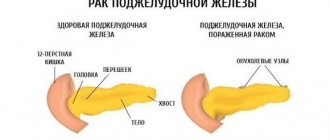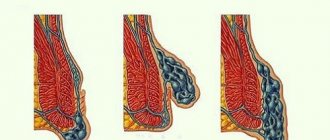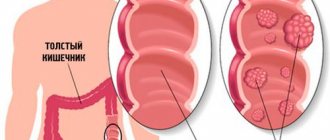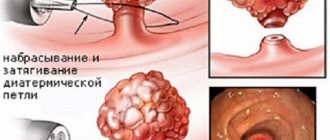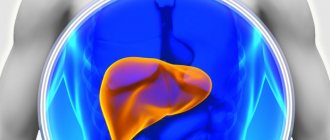Category: Oncology
Many people know that cancer is one of the most terrible pathologies, often untreatable. However, even timely therapy does not always guarantee complete healing. Of course, cancer is a formidable disease, and pancreatic malignancy is recognized as one of the most lethal oncological pathologies.
It develops, as a rule, after the age of 70 (more than 60% of patients), and in men it is 1.5 times more likely. Among the known oncological diseases, pancreatic cancer is far from the most common form, its frequency is no more than 2-3% of the total incidence, however, due to late diagnosis, the vast majority of patients cannot be saved.
Early symptoms
Early diagnosis of pancreatic diseases in general (not just cancer) is difficult due to the absence of symptoms in the early stages: pain syndrome is not inherent in the pathologies of this organ (with the exception of acute pancreatitis), and visible signs of digestive disorders begin to appear only when a significant number of cells secreting digestive enzymes are destroyed .
Among the first symptoms suspicious of pancreatic cancer are:
- pain in the epigastric region;
- epigastric discomfort;
- sudden development of acute pancreatitis (pancreatic necrosis) or type 1 diabetes mellitus against the background of complete health;
- some skin manifestations.
First signs of cancer
The exact causes of the disease are unknown. Provoking factors:
- smoking;
- poor nutrition;
- alcoholism;
- undergone surgical interventions on the abdominal organs.
There is also a hereditary predisposition to this pathology.
The first symptoms of the disease are mild in intensity, which makes timely diagnosis of oncology difficult. Pancreatic cancer in the early stages may have the following manifestations:
- frequent occurrence of painful sensations in the upper abdomen, pain - pulling and aching;
- increased discomfort during night sleep, when bending over, which is why a person suspects radiculitis and other diseases of the musculoskeletal system.
Painful sensations may have different localization depending on which part of the gland the tumor has formed. If the tumor has affected the head of the organ, the pain will be localized on the right side under the ribs or in the navel area. If there is a tumor on the tail or in the body of the gland itself, discomfort will occur in the area between the shoulder blades.
The appearance of pain symptoms has no connection with food intake or physical activity.
Pain
Pain in the upper abdomen may appear several months to a year before late signs of pancreatic cancer appear.
Such pain tends to intensify at night and in a horizontal position of the body on the back and is weakened when the body is tilted forward. Irradiation (“recoil”) of back pain is characteristic.
Early pain in pancreatic cancer is usually caused by compression of the nerve elements at the site of its origin by the tumor or increased pressure in the ducts and tissue of the pancreas and is not a sign of the inoperability of the malignant tumor - that is, it can occur at a stage when radical surgery is quite feasible.
As mentioned above, such pain is characteristic not only of pancreatic cancer, but also of other pathologies of the pancreas, liver and other digestive organs. Therefore, epigastric pain that lasts a week or more should be the reason for a thorough examination of the patient.
Pancreatic cancer is not always accompanied by pain. There may be no pain even in the terminal stages.
Main symptoms of oncology
Pancreatic cancer is most often diagnosed late, when the patient already has symptoms that cannot be ignored.
Main signs of pancreatic cancer:
- Decreased appetite, sudden loss of body weight, aversion to certain foods and dishes, mainly fatty and heavy foods, alcohol.
- Development of obstructive jaundice: the skin and mucous membranes become yellow, urine darkens, stool becomes lighter. I am concerned about the causeless itching of the skin and the enlargement of the gallbladder.
- Disorders of the digestive system: frequent diarrhea, a feeling of heaviness in the stomach (even if little food was eaten), belching, leaving a rotten taste in the mouth.
- Spread of the tumor to the tissue of the stomach or duodenum: frequent vomiting, vomit has the consistency of coffee grounds, which is explained by the presence of blood in the gastric juice, stool becomes dark black in color.
- When a neoplasm affects the splenic vein, symptoms appear that indicate a violation of the blood composition: anemia, thrombocytopenia, leukopenia.
Discomfort in the epigastric region
This term refers to unpleasant sensations in the upper (epigastric) part of the abdomen, accompanied by the following symptoms:
- a feeling of fullness in the stomach at the very beginning of a meal;
- bloating - a feeling of fullness;
- belching.
The consequence of this condition is decreased appetite and weight loss.
Epigastric discomfort is characteristic of the vast majority of pathologies of the digestive system, including non-life-threatening ones, so the doctor often does not associate such symptoms with a pancreatic tumor.
Symptoms
The development of cancer may be silent for some time, but soon the first symptoms will appear.
- Sharp pain in the upper abdomen . If you pull your legs towards your stomach, the pain decreases, but it intensifies when you tilt your torso down;
- Significant reduction in body weight . Due to a decrease in the production of pancreatic juice, food with its nutrients is absorbed less well;
- Anorexia . Decreased appetite with aversion to food. It is also possible to dislike certain foods;
- Jaundice . Yellowing of the eye sclerosis, skin and mucous membranes. These symptoms develop due to proliferation and compression of the bile duct;
- Skin itching . Manifestation of the presence of jaundice and bile crystals;
- Vomit . Compression of the junction of the stomach into the duodenum by the tumor;
- Fat in stool . The pancreatic gland is not able to secrete enzymes that break down fats;
- Diarrhea . Occurs due to a violation of the production of pancreatic juice;
- Discolored stool . Compression of the bile duct by a neoplasm with disruption of bile passage;
- Dark colored urine . Increased amount of urobilin;
- Unpleasant sensations at the site of the pancreas . Compression of the splenic vein by a tumor with enlargement of the organ of the same name;
- Insulin production disorders . Weakness, tremor, hunger, tachycardia, sometimes loss of consciousness up to coma;
- Heartburn . Due to increased production by gastritis tumor;
- Symptoms of diabetes mellitus . Frequent diuresis, sharp weight loss, constant thirst. These manifestations are associated with an increase in glucagon production.
The nature and number of symptoms often depends on the extent of pancreatic cancer. Since the above symptoms are not specific, they could easily be a manifestation of another pathology (hepatitis, diabetes mellitus, gastritis, cholelithiasis, etc.), in which case, if you suspect that you are developing the disease, you should undergo a professional examination. The doctor will diagnose the disease and prescribe adequate treatment.
Jaundice is one of the symptoms of pancreatic cancer
Symptoms of pancreatic cancer in the early stages:
- mild epigastric pain not associated with food intake, may intensify at night;
- pain in the right hypochondrium;
- pain radiates to the lower back, between the shoulder blades;
- jaundice;
- loss of appetite;
- weakness, lethargy.
Acute pancreatitis and diabetes mellitus
Tumor growth can lead to disruption of the outflow of pancreatic juice and the start of the process of autolysis (self-digestion of pancreatic tissue with its own enzymes) - the cause of the development of an attack of acute pancreatitis. If a pancreatic attack occurs like a “bolt from the blue,” that is, it is not associated with risk factors for the development of pancreatitis (alcohol abuse, overeating, the presence of biliary tract disease, and others), then such a symptom is extremely suspicious of a pancreatic cancer.
The same applies to insulin-dependent diabetes mellitus: the sudden development of this disease in the absence of other provoking factors can be explained by tumor damage to the islets of Langerhans - cellular structures located in the pancreas and producing insulin. Diabetes usually develops when the tail of the pancreas is affected, since it is in this area that the islets of Langerhans are concentrated.
What other symptoms and manifestations occur with this disease?
As it progresses, patients experience the first manifestations of damage to the liver and bile ducts. Jaundice syndrome is noted. A growing tumor located in the head of the gland compresses the bile ducts of the liver. The first signs of obstructive (that is, blocking the passage of the duct) version of jaundice appear. The woman notes the following symptoms:
- yellowish tint of the skin and mucous membranes;
- itchy skin;
- darkening of urine;
- discoloration of stool.
Cancer in women occurs without signs of icteric syndrome in 10-40% of cases. On palpation of the abdomen, a formation is noted in the projection of the pancreas. This symptom may suggest cancer.
The neoplasm can spread to the liver. In women, organ enlargement is determined. The edges of the liver are lumpy and dense. As the pathology progresses, fluid is noted in the peritoneal cavity. Other early symptoms and signs in women with pancreatic cancer:
- The first symptoms and manifestations of cholangitis, accompanied by intoxication syndrome, insufficient liver function, pain in the hypochondrium on the right.
- Dyspeptic symptoms and manifestations - diarrhea syndrome, malabsorption of substances in the small intestine.
- Signs of pancreatic stool are feces with fat, with a strong unpleasant odor.
- The first symptoms and manifestations of diabetes.
During the terminal stage, a greenish tint to the skin and signs of severe exhaustion are noted.
Symptoms of pancreatic cancer
Cutaneous manifestations of pancreatic cancer
Although the following skin symptoms are rare, they are also worth mentioning. The following skin diseases can be combined with pancreatic cancer:
- multifocal reticulohistiocytosis;
- enzymatic panniculitis;
- necrolytic migratory erythema.
Multifocal reticulohistiocytosis appears as reddish-brown nodules in the joint area that develop as a result of arthritis. Symmetrical joints are affected, the disease begins with the hands (the rash is observed on the back of them and is especially pronounced near the nails). In half of the cases, similar rashes are observed on the mucous membranes. The causes of the disease are currently unclear, but in some cases it is associated with malignant tumors of various organs and systems, including pancreatic cancer.
Enzymatic panniculitis manifests itself in the form of hard, painful dark nodules in the area of the legs and back of the feet. After some time, the skin formations soften and break through, releasing necrotic fatty masses of brown or cream color and the subsequent formation of depressed scars. The disease develops in a small proportion of patients suffering from pancreatic necrosis and pancreatic cancer under the influence of pancreatic enzymes circulating in the blood.
Manifestations of necrolytic migratory erythema are painful, itchy red scaly spots in the groin area, popliteal fossae, nasolabial folds, transforming into blisters that surround blisters filled with fluid. In a third of patients, similar lesions occur in the area of the red border of the lips and tongue. The disease is most often associated with pancreatic cancer and is caused by tumor damage to the islets of Langerhans with their excessive production of another hormone, glucagon.
If the diagnosis of one of the listed skin diseases is confirmed by laboratory tests, a thorough examination of the pancreas is required for the presence of a malignant tumor.
Often, early cancer is asymptomatic, and the listed signs may first appear only at later stages.
Manifestation of gland cancer
Symptoms of gland cancer increase as the tumor gains momentum.
In the early stages, cancer of the head of the pancreas may not make itself felt at all.
There is a saying among doctors that “cancer doesn’t hurt.” Indeed, this fact carries a great danger, because potential patients do not seek help from a doctor on time.
The manifestation of the disease will be associated with a lack of appetite, attacks of fever, when the patient’s body temperature increases sharply.
It is possible that a person will suddenly lose weight and his skin will acquire a yellow tint. He may experience serious pain. Patients also often complain that they lose their appetite.
If we look at the symptoms of pancreatic cancer in women and men in more detail, it is worth noting that first of all, neoplasms make themselves felt by pain. It will depend on the location of the tumor.
Similar early signs of pancreatic cancer appear in 75 percent of patients.
They arise due to compression of the nerve trunks or penetration of the tumor through the tissue membrane.
Less commonly, pancreatic cancer can be a consequence of blockage of the gallbladder ducts or caused by peritonitis, when an exacerbation of an attack of pancreatitis is observed.
An inflammatory infection triggers the development of a cancerous process, which will subsequently make itself felt in the form of pain.
The first symptoms of pain may be girdling in nature or spread throughout the abdominal cavity, but also be localized, radiating to the area of the right shoulder blade or back.
If a person complains of girdle pain, then a similar phenomenon is possible when the gallbladder ducts are blocked by a tumor.
Gradually, the pain syndrome will intensify, and even the skin areas will begin to turn yellow. Often, a similar development of events occurs if the head of the pancreas is affected.
Such symptoms of pancreatic cancer in women and men occur in 75 percent of cases.
The sign is specific to this type of pathology. Yellowing is caused by the fact that there is stagnation of bile in the biliary tract system.
It is triggered by the penetration of malignant areas that have entered the gallbladder duct.
Since the symptom is not caused by an infectious process, this process is mechanical.
Every day the jaundice gradually increases. Symptoms of pancreatic cancer at the next stage of development of the pathology boil down to the fact that the integument acquires a red tint, due to the accumulation of bilirubin.
It continues to oxidize, and therefore the skin acquires a greenish tint. Bile acids can irritate the receptors of the skin, and the disease progresses noticeably.
While the symptoms of pancreatic cancer may not appear in the earlier stages, later they become so intense that the itching does not allow a person to live in peace.
Itching provokes nervous outbursts and does not even allow you to sleep peacefully. Scratching marks, which are presented in multiple forms, may remain on the skin.
A sharp weight loss is observed, the patient ceases to feel the desire to eat even previously favorite foods.
It has also been noticed that meat or fatty foods seem disgusting to a person, apathy increases, as does weakness throughout the body.
Sometimes there may be attacks of vomiting or nausea. But the sequence of what symptoms gland cancer may have changes.
Itching may be the first sign of cancer, occurring even before the skin turns yellow. There are also situations when initially a person suddenly begins to lose weight.
Later symptoms
Symptoms of pancreatic cancer in later stages are associated with the growth of the primary tumor and compression of nearby organs and tissues. At this stage, mild digestive dysfunction may occur.
Symptoms vary depending on the location of the tumor - in the head or tail and body of the pancreas.
Symptoms of pancreatic head cancer
Since the head of the pancreas is located closer than other parts of the organ to the bile ducts, symptoms associated with compression of the bile ducts by the tumor and disruption of their patency come to the fore:
- stool discoloration;
- darkening of urine;
- jaundice (yellow and later dark green color of the skin);
- pain in the hypochondrium;
- itching;
- periodic increase in body temperature to subfebrile (not higher than 38°C) numbers.
The intensity of these symptoms increases gradually, itching and low-grade fever appear at the end.
Pain with cancer of the head of the pancreas is recorded less often than with damage to its body and tail.
Jaundice in cancer of the head of the pancreas, although it appears later than pain and epigastric discomfort (if the latter are present at all), is not always a sign of inoperable tumor.
Symptoms of cancer of the body and tail of the pancreas
Malignant neoplasms of these departments are most often accompanied by the following symptoms:
- vague pain in the abdomen (unlike pancreatitis, such pain is rarely observed on the left side);
- vomiting;
- constipation;
- pallor of the skin due to anemia.
Jaundice in cancer of the body and tail of the pancreas is observed less frequently, is more often accompanied by pain, and is an unfavorable sign, since it most often indicates metastases to the liver.
General symptoms
Pancreatic adenocarcinoma is considered one of the most severe forms of malignant tumors, since during its development not only there are no pronounced symptoms in the initial stages, but the disease is quite difficult to diagnose. That is why, in almost 85% of cases, patients turn to doctors only at the last stage of the disease, when the clinical picture is more pronounced and metastasis has occurred to other organs and tissues. The main and common symptoms of pancreatic cancer are:
- Pain in the abdominal area, which radiates to the left hypochondrium and lower back. In more severe stages, the pain is acute, unbearable, and constantly present.
- Yellowing of the skin and sclera of the eyes. At the beginning, the skin takes on a bright yellow tint, then brownish-green.
- Changes in urine and feces.
- Itching of the skin, which may be constant or worsen at night.
- The tumor disrupts the functioning of the gastrointestinal tract, nausea, vomiting, diarrhea, frequent flatulence appear, and there is also a lack of appetite, which leads to rapid weight loss.
With this disease, a person does not feel the desire to drink coffee, even when before the disease he was an “avid” coffee drinker, and the craving for smoking also disappears. The listed symptoms are nonspecific; their sequence and intensity may vary, since everything depends on the location of the tumor, the stage of the disease, as well as the individual characteristics of the patient’s body.
Symptoms of stage 4 (terminal) pancreatic cancer
Advanced pancreatic cancer is characterized by the growth of the primary tumor into neighboring organs, metastases to distant organs, signs of severe digestive insufficiency and general intoxication of the body, and impaired blood coagulation function. End stage symptoms:
- severe weakness;
- significant weight loss;
- ascites – accumulation of fluid in the abdominal cavity;
- migrating thrombophlebitis - blockage of the venous lumen by a thrombus, accompanied by pain and swelling of the extremities, redness of the affected area;
- enlarged lymph nodes in the supraclavicular region on the left;
- formation determined by palpation in the abdominal area.
The intensity of pain at this stage can vary from insignificant (or almost completely absent) to unbearable, relieved only by narcotic analgesics.
What exactly causes pancreatic cancer? There are no reasons that necessarily lead to this disease, but factors have now been reliably established that can, to one degree or another, increase the likelihood of a malignant tumor. These factors include:
- family predisposition - depending on the type of hereditary disease, it can increase the likelihood of pancreatic cancer by 50 times;
- chronic pancreatitis – increases the risk of developing cancer by 20 times;
- smoking – doubles the risk;
- Type 2 diabetes mellitus, which has existed for at least ten years, increases the risk by 1.5 times.
Hereditary tumor syndromes that increase the risk of developing pancreatic cancer include:
- hereditary pancreatitis (men and women are equally susceptible);
- hereditary pancreatic cancer (men and women are equally susceptible);
- diffuse familial polyposis (men and women are equally susceptible) - the formation of polyps on the mucous membrane of the colon that are prone to malignancy;
- Peutz-Jeghers syndrome (occurs somewhat more often in women) - polyposis of the stomach and large intestine, combined with pigment spots on the mucous membranes and skin;
- von Hippel-Lindau disease (men and women are equally susceptible) – characterized by multiple tumors of various organs;
- hereditary cancer of the ovaries and breast (appears only in women, and is inherited through the male line).
In people with familial tumor syndromes, pancreatic cancer often develops at a young age, whereas in the general population this disease is typical for people over 55 years of age. The risk increases many times if the manifestation of a hereditary disease is registered not in one, but in several close relatives (mother, father, siblings). Fortunately, familial tumors are quite rare.
Type 2 diabetes mellitus is considered one of the most significant predisposing factors due to its high prevalence in the population.
Tobacco smoking acts as an independent risk factor and increases the risk when combined with other factors. The risk is directly dependent on the length of smoking and the number of cigarettes smoked daily.
Chronic pancreatitis is not only a risk factor - changes in the organ associated with this disease significantly complicate the diagnosis of pancreatic cancer.
Contrary to popular belief, the connection between pancreatic cancer and dietary habits (abuse of alcoholic beverages, an abundance of carbohydrate and fatty foods in the diet, overeating) has not been proven to date. However, dietary errors can influence the development of chronic pancreatitis, which increases the likelihood of pancreatic cancer.
First signs
Prostate cancer in women does not manifest itself clinically for a long time. Only nonspecific symptoms are possible, the first signs are:
- anxiety states;
- insomnia;
- depressive states with attacks of aggression, crying;
- memory impairment;
- anorexia combined with anxiety and depression;
- change in judgment, thinking;
These signs appear at the very beginning of the disease. In addition to anxiety and depressive conditions, it is possible to identify neurological disorders:
- symptoms of neurasthenia;
- manifestations of anxiety neurosis;
- signs of melancholy and others.
In patients with prostate cancer, 41-76% show manifestations of mental disorders, 50% show signs of depressive conditions.
As cancer progresses, mental symptoms and manifestations become more pronounced. The most common condition in women that precedes prostate cancer is depression.
Later nonspecific symptoms include:
- Pain in the pancreas area spreads to the lumbar region, sometimes girdling pain. The symptom is worse at night.
- Decreased appetite (anorexia).
- Nausea, vomiting that does not bring relief.
When the first symptoms appear, the presence of the tumor itself and its first metastases in the kidneys and mammary gland are already possible.
Early diagnosis
Pancreatic cancer can be accurately determined only using instrumental and laboratory research methods.
Indications for instrumental diagnostics:
- presence of symptoms suspicious for pancreatic cancer;
- belonging to risk groups.
The most accessible and common instrumental methods include esophagogastroduodenoscopy (EGD) and conventional (transabdominal) ultrasound, but they are often not very informative.
More informative methods include contrast-enhanced computed tomography (CT), magnetic resonance imaging (MRI), magnetic resonance cholangiopancreatography (MRCP), endo-ultrasound (ultrasound examination through the wall of the stomach). Endoscopic retrograde cholangiopancreatography (ERCP), despite the high accuracy of the result, is rarely used because it is associated with a high risk of severe complications.
Under endo-ultrasound control, a biopsy is also taken - a small sample of pancreatic tissue from the lesion for histological examination, which allows us to determine the nature of this lesion.
The listed methods are used to identify a tumor and assess the possibility of radical surgery.
If you suspect pancreatic cancer, you should consult a gastroenterologist or gastroenterologist with additional oncological specialization. It is more advisable to carry out diagnosis and treatment in specialized oncology centers.
Diagnostic tests
One of the most accessible and justified methods for detecting pancreatic cancer today is an ultrasound examination of the abdominal cavity.
Due to the qualifications of the doctor and the quality of the equipment used, a tumor can be detected if it is larger than 2 cm.
If the diagnosis is confirmed, it is necessary to clarify the size, position of the tumor, as well as to what extent it has involved nearby organs in the process.
In this case, it is recommended to resort to another method of studying the body. This is a computed tomography scan.
The analysis is indeed very reliable, but very expensive. If the tumor is more than 3 cm in size, then CT will determine all of the above characteristics.
It is worth considering that this study is associated with a large dosage of x-ray radiation, so it does not need to be carried out frequently or in situations where its use can be dispensed with.
This study is comparable in information content to MRI. Only there are limiting factors for magnetic resonance imaging.
The examination cannot be carried out if there are metal implants in the body, which means metal plates, prosthetic joints, artificial heart valves and other devices that support the normal functioning of the body.
These methods, which help identify a tumor, make it possible to clarify the location of the lesion and the tumor area.
It will also be necessary to conduct positron emission tomography, which is aimed at identifying the tumor and the presence of metastasis.
For these purposes, a radionuclide must be introduced into the body. Cancer cells actively absorb this substance.
During this process, photographs are taken with a special device to help capture how the substance is distributed in the human body.
Such research is very important during the proposed operation.
It allows you to assess the volume required for surgery, as well as whether it is necessary to use additional treatment methods such as radiation or chemotherapy.
The description of methods for diagnosing pancreatic cancer can go on for a long time, but the most important thing that needs to be clarified is that even at an early stage of the pathology, it is important to follow all the instructions of the attending physician.
You need to trust a specialist, ask questions of interest, and do not hesitate to say what exactly is bothering you. Every nuance in the treatment of oncology plays a big role.
Medicine does not stand still; new methods of treating pathology have been developed, even if recently some cases were recognized by doctors as inoperable.
All this indicates that there is a chance for recovery; you need to gain strength and faith in the best.
Pancreatic cancer staging
According to the TNM classification, the following stages are distinguished:
- 0 (TisN0M0) – the primary tumor does not extend beyond the epithelium; no metastases;
- IA (T1N0M0) – the primary tumor does not extend beyond the pancreas, its maximum size is no more than two cm; no metastases;
- IB (T2N0M0) – the primary tumor does not extend beyond the pancreas, its maximum size is more than two cm; no metastases;
- IIA (T3N0M0) – the primary tumor extends beyond the pancreas, but without involvement of large blood vessels; no metastases;
- IIB (T1-2-3N1M0) – primary tumor of any size, does not extend or extends beyond the pancreas, but without involvement of large blood vessels; there are metastases to regional lymph nodes; there are no distant metastases;
- III (T4N0-1M0) – the primary tumor extends beyond the pancreas with the involvement of large blood vessels; regional metastases are present or absent; there are no distant metastases;
- IV (T1-2-3-4N0-1M0-1) – primary tumor of any size and spread; there are regional and distant metastases.
The description is often supplemented by other parameters, including the degree of differentiation (malignancy) of the tumor, the degree of damage to the peritoneum and bile ducts. This classification is necessary for choosing treatment tactics.
Types of pancreatic head cancer
Types of cancer of the head of the pancreas are described based on localization, prevalence, and tissue histology.
The cytological picture allows us to distinguish the following types:
- • adenocarcinoma;
- • squamous;
- • acinar cell;
- • cystadenocarcinoma;
- • undifferentiated.
It is necessary to differentiate them from cystadenomas, some types of which are benign. There are also icteric, anicteric and cachectic forms of cancer of the head of the pancreas. The international TNM classification takes into account size, germination and distant metastasis.
Treatment
The primary tumor is usually insensitive to radiation and chemotherapy, so radical treatment includes surgery - complete or partial excision of the pancreas, excision of the spleen, duodenum, and bile duct.
To suppress metastases that are more sensitive to conservative treatment, chemotherapy is used before or after radical surgery, sometimes in combination with radiation treatment.
If radical surgery is not possible, palliative (to improve the quality of the remaining life) treatment is used, including surgery, aimed at removing bile and restoring digestive functions.
Forecasts
Survival depends on the stage of the tumor and, therefore, the possibility of radical treatment. After radical operations, the five-year survival rate of patients reaches 20-25%.
In addition, the prognosis depends on the histological type of the tumor - its microscopic variety. There are less and more malignant tumors. The latter grow quickly and metastasize, have a tendency to relapse, and respond poorly to treatment. Thus, the five-year survival rate after radical surgery for ductal adenocarcinoma may not reach 1%, and after similar treatment for mucinous cystadenocarcinoma - 45-65%.
In general, the prognosis is unfavorable - if we consider all cases (tumors with different histotypes and degrees of prevalence), the five-year survival rate is less than 2-5%. The reasons are late diagnosis, resistance to conservative treatment methods characteristic of most malignant pancreatic tumors, and early metastasis.
The quality of life after radical operations has an inverse relationship with their volume. If the pancreas is completely removed, the patient needs lifelong replacement therapy with insulin and pancreatic enzymes, and such treatment does not always achieve a satisfactory quality of life. The same applies to the removal of part of the small intestine and bile ducts. Despite reconstructive operations, the patient may remain disabled.
The smaller the volume of the operation, the higher the quality of life.
Clinic
The symptoms of the disease depend on the location and type of tumor. The initial stage of this pathology can manifest itself in different ways. As a rule, the first symptoms and signs of pancreatic cancer are vague and not specific, so a patient with this disease often does not even pay attention to them.
The first symptoms of pancreatic cancer appear as follows:
- rapid weight loss without dieting;
- digestive dysfunction;
- lack of appetite;
- flatulence of the intestines and stomach;
- deep pain in the lower back;
- ascites;
- increased fatigue;
- cholangitis;
- cachexia;
- drowsiness;
- hyperthermia (37-39.5 °C);
- Courvoisier's sign;
- decreased ability to work;
- hepatomegaly (increase in liver size);
- apathy.
Yellowness of the sclera is a characteristic symptom of pancreatic cancer in the early stages of development of the pathology.
This is how the first signs of pancreatic cancer appear at an early stage of its development. As the malignancy grows larger, other symptoms of pancreatic cancer appear:
- jaundice;
- itching all over the body;
- thirst;
- dark urine;
- steatorrhea (presence of lipids in stool);
- light stool;
- nervous exhaustion;
- intolerance to meat and fats;
- hypertrophy of the liver and gallbladder;
- increased sweating;
- dizziness;
- hypertrophy of regional lymph nodes;
- anxiety;
- polyuria, hyperglycemia, polydipsia (symptoms of diabetes mellitus);
- problems with menstruation;
- decreased libido;
- facial redness;
- formation of trophic ulcers on the lower extremities.
Note. In fact, 85-90% of patients diagnosed with pancreatic cancer have metastases in various vital organs. The clinical picture of the disease during the formation of metastases depends on their location. Cancerous tumors in the abdominal organs can cause internal bleeding.
Severe itching of the skin is observed when the functions of the liver and gallbladder are impaired.
Advice! If you have discomfort in the pancreatic gland, you should contact a clinic for qualified help from a doctor. Early diagnosis of cancer increases the survival rate of patients.
Stages of pancreatic cancer
There are four stages of cancer development:
- Stage I. The malignancy is limited to the pancreatic gland.
- Stage II. Carcinogenic cells affect nearby organs and possibly lymph nodes.
- Stage III. The oncological process spreads beyond the pancreatic gland, metastases are detected in the lymph nodes.
- Stage IV. Metastases affect the brain, spinal cord, bone marrow, lungs, intestines, ovaries and liver.
Forecast
Many cancer patients are interested in the question: how long do they live with pancreatic cancer? Analysis of statistical data showed that the average survival rate of patients for five years without appropriate therapy is 2-3%. Active wellness procedures in modern cancer centers increase the survival rate by up to 20%. The psycho-emotional state of a person is of no small importance in the treatment of the disease.
Symptoms of pancreatic cancer often appear in the last stages of the disease
